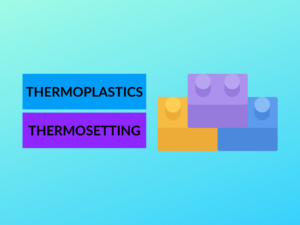What is Thermoplastic?
Thermoplastics are a type of polymer that can be melted and reshaped multiple times without undergoing any significant chemical change. They are made up of long polymer chains that are interconnected by weak intermolecular forces. As a result, when subjected to heat, the chains can slide past each other, allowing the material to soften and become malleable. When cooled, it solidifies again without losing its original properties.
Examples of Thermoplastics:
- Polyethylene (PE)
- Polypropylene (PP)
- Polyvinyl Chloride (PVC)
- Polystyrene (PS)
- Acrylic (PMMA)
- Polyethylene Terephthalate (PET)
- Polycarbonate (PC)
Uses of Thermoplastics:
Thermoplastics find applications in various industries due to their versatile properties. Some common uses include:
- Manufacturing of plastic bottles, containers, and bags
- Automotive parts
- Electronic components
- Pipes and plumbing systems
- Insulation materials
- Textile fibers
What is Thermosetting Plastic?
Unlike thermoplastics, thermosetting plastics are polymers that undergo irreversible chemical changes when heated. Once set, they cannot be melted or reshaped by heating. The polymer chains in thermosetting plastics are cross-linked, forming a three-dimensional network structure. This cross-linking makes them strong and resistant to heat and chemicals.
Examples of Thermosetting Plastics:
- Epoxy
- Polyurethane (PUR)
- Phenolic
- Melamine
- Urea-formaldehyde
- Silicone
Uses of Thermosetting Plastics:
Due to their durability and heat resistance, thermosetting plastics are often employed in applications such as:
- Electrical insulators
- Aircraft and aerospace components
- Adhesives and sealants
- Automotive parts (e.g., brake pads, clutch facings)
- Construction materials (e.g., laminates, countertops)
Differences between Thermoplastic and Thermosetting Plastic:
| Difference Area | Thermoplastic | Thermosetting Plastic |
|---|---|---|
| Melting Point | Low | High |
| Chemical Structure | Linear chains | Cross-linked network |
| Reversibility | Can be melted and reshaped multiple times | Irreversible and cannot be remolded |
| Strength | Lower | Higher |
| Heat Resistance | Lower | Higher |
| Processing | Easier and faster | More complex and time-consuming |
| Uses | Plastic bags, containers, pipes, automotive parts | Electrical insulators, aerospace components, adhesives |
| Cost | Generally cheaper | Can be more expensive |
| Recyclability | Can be recycled | Difficult to recycle |
| Environmental Impact | Higher carbon emissions during production | Lower carbon emissions during production |
Conclusion:
In summary, thermoplastics are plastic materials that can be melted and reshaped multiple times, whereas thermosetting plastics are irreversibly set once heated. Thermoplastics have lower strength and heat resistance compared to thermosetting plastics. The two types also differ in chemical structure, processing methods, cost, recyclability, and environmental impact. Understanding these differences is crucial for selecting the appropriate plastic material for various applications.
People Also Ask:
- Can thermoplastics be recycled?
Yes, thermoplastics can be recycled as they can be melted and reshaped multiple times. - What are the advantages of thermosetting plastics?
Thermosetting plastics offer high strength, heat resistance, and resistance to chemicals. - Are thermosetting plastics biodegradable?
No, thermosetting plastics are not biodegradable as they do not break down easily in the environment. - Which type of plastic is suitable for electrical insulation?
Thermosetting plastics, such as epoxy and phenolic, are commonly used for electrical insulation due to their strong insulating properties. - Can thermosetting plastics be melted?
No, thermosetting plastics cannot be melted as they undergo irreversible chemical changes when heated. - Are thermoplastic materials more cost-effective?
Generally, thermoplastic materials are cheaper compared to thermosetting plastics. - Can thermoplastic and thermosetting plastics be mixed?
No, it is not possible to mix thermoplastic and thermosetting plastics as they have different chemical structures and curing mechanisms. - Do thermosetting plastics release toxic fumes when heated?
Some thermosetting plastics, such as melamine, can release toxic fumes when heated at high temperatures. - Are thermoplastics suitable for high-temperature applications?
Thermoplastics have lower heat resistance compared to thermosetting plastics, so they may not be suitable for high-temperature applications. - Can thermoplastic and thermosetting plastics be combined?
It is possible to combine thermoplastic and thermosetting plastics in composite materials to take advantage of both their properties.


